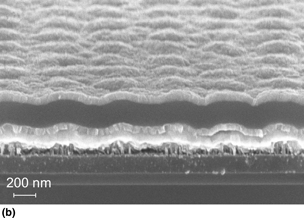Article contents
Efficiency enhancement via metal-coated porous amorphous silicon back reflectors incorporated in amorphous silicon solar cells
Published online by Cambridge University Press: 20 April 2016
Abstract

We present two straightforward and cost-effective methods, based on metal-assisted chemical etching and a direct imprinting technique, to fabricate metal-covered porous amorphous silicon back reflectors for amorphous silicon solar cells. We demonstrate an increase of approximately 30% in both short-circuit current and overall efficiency with respect to a cell with a flat metal back reflector. This is achieved by implementing light trapping via either a roughened porous amorphous silicon layer or an imprinted periodic grating. This work provides a pathway to increase amorphous silicon solar cell efficiency via increased absorption without significantly impacting processing costs.
- Type
- Plasmonics, Photonics, and Metamaterials Research Letter
- Information
- Copyright
- Copyright © Materials Research Society 2016
References
- 1
- Cited by




